|
WHALES AND DOLPHIN WATCHING IN ST LUCIA |
| St. Lucia Population: 150,630. Land area: 616 sq km. Tourist arrivals by air: 248,406 (+5.4% on prev. yr.) Tourist arrivals by cruise ship: 310,263 (+71.9% on prev. yr.) Total Tourist Expenditures: $283.7 million USD. Tourism Budget: $5.5 million USD. GDP at factor cost: $488.2 million USD. 1994 figures on whale watching: Nil. 1998 figures on whale watching: <100 people and $7,500 USD in total revenues. |
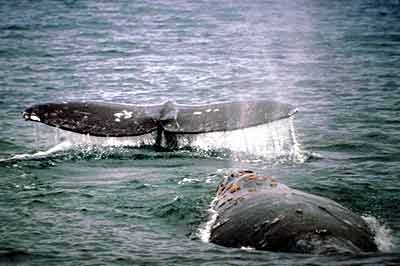 |
|
Whale-watching ports (current or potential):
Soufrière, Castries, Vieux Fort. Land-based viewing sites: elevated locations between Castries and Gros Ilet, including Pigeon Pointe; Anse Chastanet (near Soufrière); promontories around Vieux Fort and from the Maria Islands. Whale-watching potential: Outstanding. (Figures above are latest figures for 1997, except as noted.) |
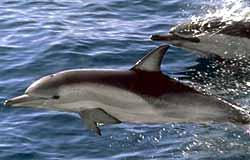 |
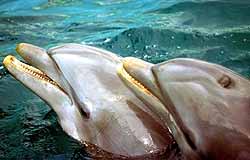 |
St. Lucia achieved its independence within the British Commonwealth in 1979. Even more than most other former Caribbean colonies, St. Lucia has a somewhat schizophrenic cultural history, having changed hands 14 times between the French and British. Most of the people are of African descent; the official language and government traditions are English; but the culture is French Creole. St. Lucia is a mountainous, verdant island with volcanic peaks and lush, fertile valleys. The magnificent centrepiece is some 19,000 acres (7,700 ha) of tropical rain forest maintained in forest and nature reserves. |
| To date, more than most other Eastern Caribbean countries, St. Lucia has relied on agriculture as an economic mainstay. Unfortunately, that agriculture was bananas which alone provided 70% of export earnings and employed 40% of St. Lucia's people. With the World Trade Organisation demanding that EU quotas on bananas must be lifted, St. Lucia's farmers will no longer be able to compete with the big growers in Latin America. The writing has been on the wall for a few years and meantime St. Lucia has worked hard to expand its tourism industry to fill |
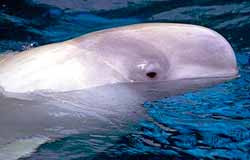 |
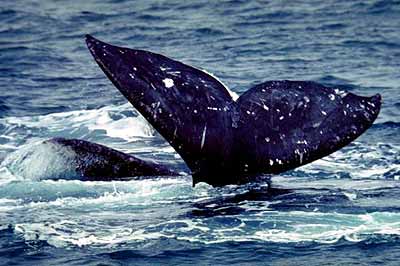 |
the anticipated void. Compared to many neighbouring countries in the Caribbean, St. Lucia was slower to promote itself and to try to attract more tourists. It has only been seriously involved with tourism for fewer than 20 years, but now it is coming on strong, with numbers climbing every year. The greatest asset of the country is its largely unspoilt nature setting: the substantial tropical rain forest, the coral reefs and clear, clean Caribbean sea, and the wildlife both on land and marine — all of which are |
|
proving more and more valuable as they rapidly disappear in the rest of the world. In terms of tourism infrastructure, St. Lucia offers numerous rustic, friendly lodgings as well as low-key luxury hotels. The island has considerable cultural appeal, with colonial French architecture, Native Indian artefacts, an excellent jazz festival, and the Creole culture which makes for good restaurants and Carnival celebrations. However, the negative side of the recent turn to tourism development is already starting to show itself. The newer 'all-inclusive' resorts — holiday compounds — totalled ten as of late 1998. These often British, American or Jamaican-owned operations bar non residents and encourage visitors to use only their facilities, alienating islanders and contributing little to the local economy. With the promotion of these sorts of resorts, and other investments, tourism has been criticised for not bringing enough benefits to rural residents. Some have suggested that it is just growing pains, and that fine-tuning of tourism industry directives will solve these and other problems. One part of the solution, begun in 1998, is the defining of a new tourism sector 'Nature Heritage Tourism'. Funded by the European Union and the Government of St. Lucia, a three-year programme, called the St. Lucia Heritage Tourism Programme, has been designed to offer various kinds of economic, development and marketing assistance in order to promote nature/heritage tourism in local communities. |
| The expressed rationale is to ensure that the benefits from tourism are distributed more evenly throughout the island, especially to rural communities while ensuring minimal impact on natural resources. The overall aim is to make St. Lucia 'the most diversified and sustainable tourism destination in the Caribbean'. The recognition of the importance of maintaining nature as the backbone of this new directive is vital. This recognition of the importance of maintaining marine resources has contributed to the recent designation of some 23 modest-sized marine protected areas all around the island, mostly centering on coral reefs and mangroves. The Soufrière Marine Management Area, for example, which contains four different marine reserves, has a balanced, comprehensive programme modelled on the biosphere reserve concept which includes protection, management, and local education while allowing or some tourism and fishing development. Some of the reserves have populations of cetaceans as regular visitors, though official recognition of cetaceans has been slow to come. There is no listing for whale watching in the 98-page A4 colour glossy Visions St. Lucia 1998/99 Tourist Guide. In the comprehensive 36-page St. Lucia Marine Guide 1998/99, there is not even a single mention of a dolphin or whale, much less of 'whale watching'. |
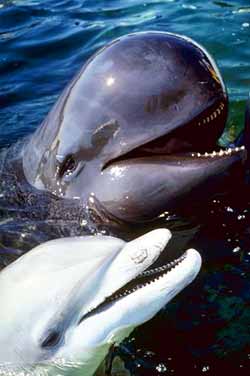 |
| The most common cetaceans seen by boat year-round in St. Lucian waters are various dolphins, especially spinner and pantropical spotted, sighted from inshore to 2-3 miles offshore (3-5 km) and short-finned pilot whales some 3-20 miles (5-32 km) from shore. Sperm whales are also regularly seen off the northwest, west and southwest of the island, as well as false killer whales. Occasionally, Bryde's whales, as well as humpback whales (several 1999 sightings off the NE tip of the island), are seen in the period from January to April. The regular hunting of pilot whales has occurred mainly (though not entirely) on the south-western and eastern coasts of St. Lucia (away from the main tourism areas in the northwest); pilot whales and various dolphins have been landed regularly at the following ports: Soufrière, Choiseul, Laborie, Vieux Fort, Micoud, Dennery, as well as Castries, but most have been reported at Vieux Fort, at the southern tip of St. Lucia, in the latter part of the year. Pilot whales can also be seen (and are sometimes caught) out of the northwest and the peak period for sightings is November-December, though they have been seen in every month, often travelling in pods of 20 to 100 animals. There are other regular sightings and landings from hunts of rarer cetaceans, including dwarf and/or pygmy sperm whales, and possibly goosebeaked and Antillean beaked whales. |
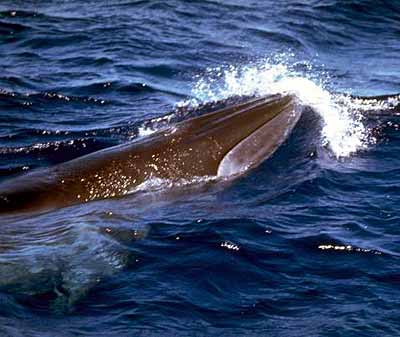 |
The reported sightings have been off the Pitons on the west side of St. Lucia out of the port of Soufrière, sometimes as close as a mile (1.6 km) from shore, especially during the months of April through July. According to St. Lucia's Chief Fisheries Officer, the best sites where cetaceans occur commonly and in fairly large numbers are in Soufrière Bay, on the southwest coast which has deep waters close to shore, and off northwest St. Lucia, from in the lee of the island to the waters between St. Lucia and Martinique. The second locale is closest to the main tourist area, although both are easily accessible on half-day boat trips. |
| A third location at Vieux Fort was not recommended, perhaps in part because it is a centre for dolphin hunting and is away from the main tourist areas, although the Maria Islands, off Vieux Fort, are a special attraction for nature lovers. Land-based sighting opportunities largely take advantage of the above three areas of cetacean concentration. Recommended are various spots along the west coast, in the lee of the island, especially from slightly elevated locations in the northwest from Castries to Gros Islet, including Pigeon Pointe. Also, at Anse Chastanet (near Soufrière), a number of dolphin and large whale sightings were recorded by Randall Reeves. Headlands and promontories around Vieux Fort and from the Maria Islands should also be investigated for possible land-based whale and dolphin watching. With tourists already coming for the diving and other marine activities, as well as for the nature offerings on land, a substantial whale and dolphin watching industry would seem to be a natural for St. Lucia. However, several problems have prevented the tours from becoming popular to the extent that they have in, e.g., Dominica. One is that fishermen still take cetaceans in some numbers around St. Lucia. There may be a slight uneasiness with the ascendancy of whale watching in other parts of the world and whether this might threaten the fishermen's cetacean-hunting income. It might be useful to measure the potential benefits in a socioeconomic study, weighing the potential of whale and dolphin tourism, and the value of nature to St. Lucia's image, vs. the value from hunting to these families. |
| There may also be some conservation implications to these hunts. Although scientists are aware of them (eg., Reeves 1988 and pers. comm.), the hunts are not monitored and the IUCN status of the species hunted is insufficiently known. In 1997, the St. Lucia Whale & Dolphin Watching Association (SLWDWA) was formed to promote the development of high quality whale watching around St. Lucia. Two founder operators' signed up with founder-association secretary Jane Tipson, who set up an office next |
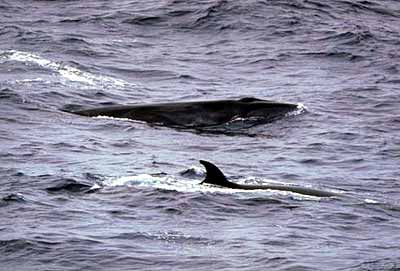 |
| door to her own tour company Toucan Travel, at Rodney Bay Marina in Castries. SLWDWA set up a website, an environmental reference library at a local cafe, and began working with international scientists and whale watch authorities to come up with acceptable regulations for whale watching in St. Lucia. Whale watching was soon listed as a regular offering in at least two of the major Caribbean-wide guidebooks. In truth, whale watching has been poised to take off now for 2-3 years, with operators advertising whale watching and taking a few people out, but regular popular tours only started in December 1998. Sunlink Tours, which offers a wide variety of adventure tours on various boats, now lists whale and dolphin watching as one of its featured tours, and after 3 months operation had 269 bookings at $70 US per person. The trips include hydrophones to listen to the whales. As of March 1999, a second company had begun offering the tours, taking about 30 visitors a week over the first two months. These numbers show that demand is there and that local operators are willing to invest to meet that demand. It would not be surprising if several thousand people were going whale watching from St. Lucia by the year 2000. Still, if whale watching is to become successful and of enduring value in St. Lucia, there will need to be enforced regulations, naturalist guides on the boats, and an education programme that helps ensure the conservation of marine fauna. SLWWDA has already taken the lead in promoting high quality whale watching and in providing information and technical assistance. |
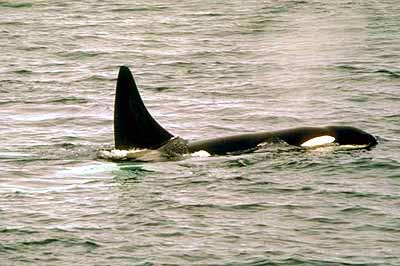 |
But much more clearly needs to be done if whale watching is to develop into a valuable, enduring industry that will bring economic, social and environmental benefits to the country. With St. Lucia's endangered leatherback turtles (landing on the beaches from May to August to lay their eggs when there are all-night 'turtle watches'), rare parrots (which can be seen on a day hike through the rain forest), a frigate bird sanctuary and numerous other birding opportunities, there is already a reason for nature tourists to visit. |
|
The St. Lucia Heritage Tourism Programme could well help provide more focus toward the sea, integrating whales and dolphins with existing marine protected areas and the diving/ yachting tourism sector. One community-based idea would be to establish environmentally-friendly interpretation and visitor centres, signs and murals focusing on whales and dolphins, situated at good lookouts or possible whale watch ports especially in the northwest of the country. This would help put whales and whale watching on the map for locals and tourists and it could help greatly enhance the nature tourism sector. St. Lucia: Whale watching regulations These regulations are being made into law, though they have yet to be actively enforced or practised (Carlson 1998). 1) Boat: Boats used for marine mammal watching should have proper functioning engines and rapid response steering. In addition, engines should be installed so as to provide minimal noise and vibration. 2) Swimming: No swimming with marine mammals is permitted. 3) Feeding: Do not attempt to feed marine mammals, or throw food or garbage in the water near marine mammals. 4) Approach Strategy: i) Do not approach any fishing activity. However, if approached by a group of fishermen while whale watching, the watching party gets priority. ii) No filming or photo shooting of any fishing activity is permitted. iii) Always maintain a good lookout at all times when in the vicinity of marine mammals. iv) Use extreme caution when approaching marine mammals. v) Within four hundred metres (400 m) of the nearest mammal: a) reduce noise to a minimum; b) make no sudden changes in speed or direction (except in an emergency); c) do not reverse (except in an emergency); d) travel at no more than two (2) knots faster than the slowest mammal at an idle no wake speed. vi) Do not approach a resting animal; keep a minimum distance of four hundred metres (400 m). vii) No more than two (2) vessels should attempt to watch a marine mammal or group of marine mammals. Only one vessel is permitted to be in contact with mammals, the other vessel has to maintain a distance of four hundred metres (400 m) from any animal or group of animals, until the permitted watching time has elapsed. Radio contact between the two vessels has to be maintained at all times. Approach and departure must be carefully co-ordinated. Total watching time shall not exceed thirty (30) minutes. viii) Do not approach an animal head-on. Approach parallel to the animal or slightly to the rear of the animal. Do not cause the animal to change direction. ix) Keep a minimal distance of one hundred metres (100 m) from the closest animal. x) Do not box an animal or group of animals in, or cut off their path or prevent them from leaving. xi) Keep a minimum distance of two hundred metres (200 m) from a mother with a calf. xii) Do not separate or scatter a group of animals or come between a mother and calf. xiii) If an animal shows signs of disturbance, abandon contact immediately. xiv) Do not approach a marine mammal or a group of mammals under sail. 5) Stopping: i) When stopping to watch a marine mammal, place the engine in neutral or allow motor to idle for a short period (approx. 1 minute) before stopping. ii) If an animal approaches closer than one hundred metres (100 m), the vessel should be stopped with the engine in neutral iii) Do not chase an approaching animal. iv) Be wary of any animal that appears tame. v) Keep clear of flukes. 6) Departure: i) Move off slowly at an idle no wake speed. Wait until boat is at least four hundred metres (400 m) from nearest animal before increasing speed. ii) If an animal dives, wait at least five (5) minutes before starting or engaging engine. 7) Other: i) No aircraft is to be used for marine mammal watching. ii) The Department of Fisheries reserves the right to send a Fisheries Officer on any marine mammal watching trip as an observer for research purposes. iii) Commercial fishing and scientific research requires special permission from the Chief Fisheries Officer. iv) Copies of all data collected on whale watching trips must be submitted to the Dept. of Fisheries. Acknowledgments: Jane Tipson (SLWDWA, Toucan Travel), Randall Reeves, Reeves 1988, Luntta 1998, Mark Carwardine, Samantha Barnard (Sunlink Tours), Keith E. Nichols and Jeannine Compton (Ministry of Agriculture, Lands, Fisheries and Forestry), Brian Louisy (Exec. Director, The St. Lucia Chamber of Commerce Industry and Agriculture), Ingrid Millar (St. Lucia Tourist Board), McNeill 1997, Allsop and Charles 1998, McDaniel 1999, Klinowska 1991, CTO 1997. |